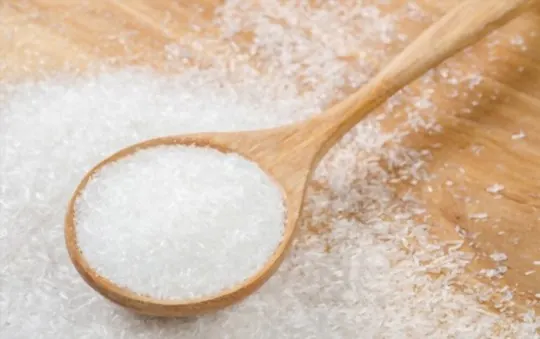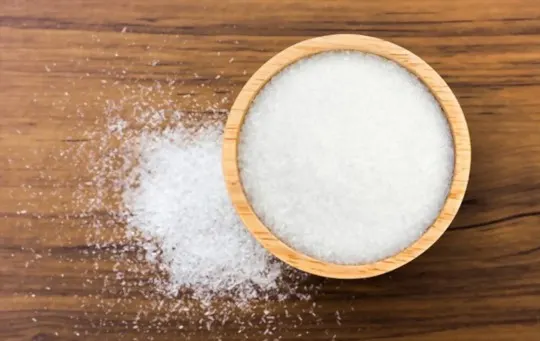People have been using monosodium glutamate (MSG) as a flavor enhancer for almost 100 years.
In this post, you will learn about MSG, a commonly used food additive found in numerous variants of foods.
MSG is a white powder that dissolves easily in water and splits into sodium and free glutamate.
But the question is, “what does MSG taste like?”.
Many people wonder what MSG tastes like and how to use it properly.
MSG has a pleasant flavor referred to as umami, which is a Japanese term.
People often consider umami as the fifth taste of food.
It doesn’t have any smell.
What is MSG?

Monosodium glutamate (MSG) is a widely used supplementary flavor in the food industry.
It is derived from the amino acid, glutamic acid and is generally added to a variety of foods.
MSG stems from L-glutamic acid, which is a nonessential amino acid.
This acid prevails naturally in various foods, such as tomatoes, cheese, and mushrooms.
The US Food and Drug Administration (FDA) indexes MSG to be a food ingredient that is “Generally Recognized As Safe” (GRAS).
However, some people may be sensitive to it and experience unfavorable reactions to it.
These reactions are collectively known as MSG symptom complex and may encompass symptoms such as headaches, flushing, sweating, and chest pain.
However, it is vital to record that these symptoms are usually mild and self-limiting, and not everyone experiences them.
If you are concerned about your intake of MSG, you should carefully assess food labels and choose products that do not comprise added MSG.
What Does MSG Taste Like?

Are you wondering what MSG tastes like? When you consume it by itself, MSG doesn’t have a particularly strong or distinct flavor.
Instead, it has a mild, slightly savory taste, often compared to salt.
Still, when you add it to dishes, MSG works its magic by boosting its flavor profiles.
One of the leading reasons why MSG is so effective at strengthening the taste of food is because it triggers the umami receptors on your tongue.
Umami is usually implied as the fifth taste.
You can define it as a savory, meaty flavor that adds depth and richness to dishes.
Fusing MSG with food accentuates the umami flavor, making the dish taste even more delectable.
Many people have opined that the flavor of MSG as being comparable to that of the sweet meat of a crab.
However, this flavor is not overwhelming or sharp but rather subtle and mild.
Rather, it simply enriches the existing flavors of the dish, making it more luscious and enjoyable.
The texture of MSG is similar to that of salt, but it doesn’t have the same degree of saltiness.
It has a moderate zest that fluctuates, banking on which taste buds are activated.
Despite the rumors and myths that have circulated about MSG over the years, the truth is that it doesn’t actually distort the taste of food.
It simply enhances the prevailing flavors, making them more pronounced and enjoyable.
This is why MSG is often used as a flavor enhancer in canned goods, fast foods, and other processed foods.
How to Use or Cook with MSG?

MSG delivers two ample benefits when you use it in cooking: it adds flavor and boosts the taste of the other ingredients.
One advantage of MSG is its potential to instill an umami taste in food, which makes it more scrumptious.
In addition, people frequently use MSG to season and refine the sour and salty taste.
This common seasoning is popular in several cookeries, entailing dishes from the Caribbean, Asia, and Latin America.
Many people add MSG in meat rubs, eggs, fish, soups, and gravies as well as to stabilize the bitter taste of certain vegetables.
It is important to remember that MSG is not a cure-all for bland dishes.
Using too much MSG can elicit an unwelcome flavor, and it may not enhance the taste of sweet or bitter foods.
If you intend to replace salt with MSG in your recipe, it is best to substitute 1/3 of the salt with MSG.
When using MSG, you only need a small amount to obtain the desired effect.
This is because glutamate, the active ingredient in MSG, has a natural affinity for the umami receptors on your tongue.
As a result, even a small amount of MSG can considerably enhance the flavor of a dish.
Conclusion
In conclusion, MSG has a benign, slightly savory flavor when consumed on its own.
However, when put into dishes, it accentuates the umami flavor, which is usually established as meaty, earthy, and flavorful.
While there are some who have related the taste of MSG to crab meat, it is essential to recount that the flavor is not overpowering or intense.
If you’re looking to add more flavor to your dishes, consider using MSG in soups, stews, gravies, stocks, broths, dressings, sauces, vegetables, meats, seafood, and poultry.
MSG can add a glorious spurt of flavor to your favorite recipes.

What Does MSG Taste Like? Does it Taste Good?
Ingredients
- MSG
- Ingredients from your favorite recipes
Instructions
- Depending on the ingredients used, the cooking method, and the type of dish, the taste of the food can vary greatly.
- Make sure to select a recipe that will elevate the food’s original flavor, and enjoy experimenting with different recipes!

Andrew Gray is a seasoned food writer and blogger with a wealth of experience in the restaurant and catering industries. With a passion for all things delicious, Andrew has honed his culinary expertise through his work as a personal chef and caterer.
His love for food led him to venture into food writing, where he has contributed to various online publications, sharing his knowledge and insights on the culinary world. As the proud owner of AmericasRestaurant.com, Andrew covers a wide range of topics, including recipes, restaurant reviews, product recommendations, and culinary tips.
Through his website, he aims to inspire and educate fellow food enthusiasts, offering a comprehensive resource for all things food-related.

Leave a comment